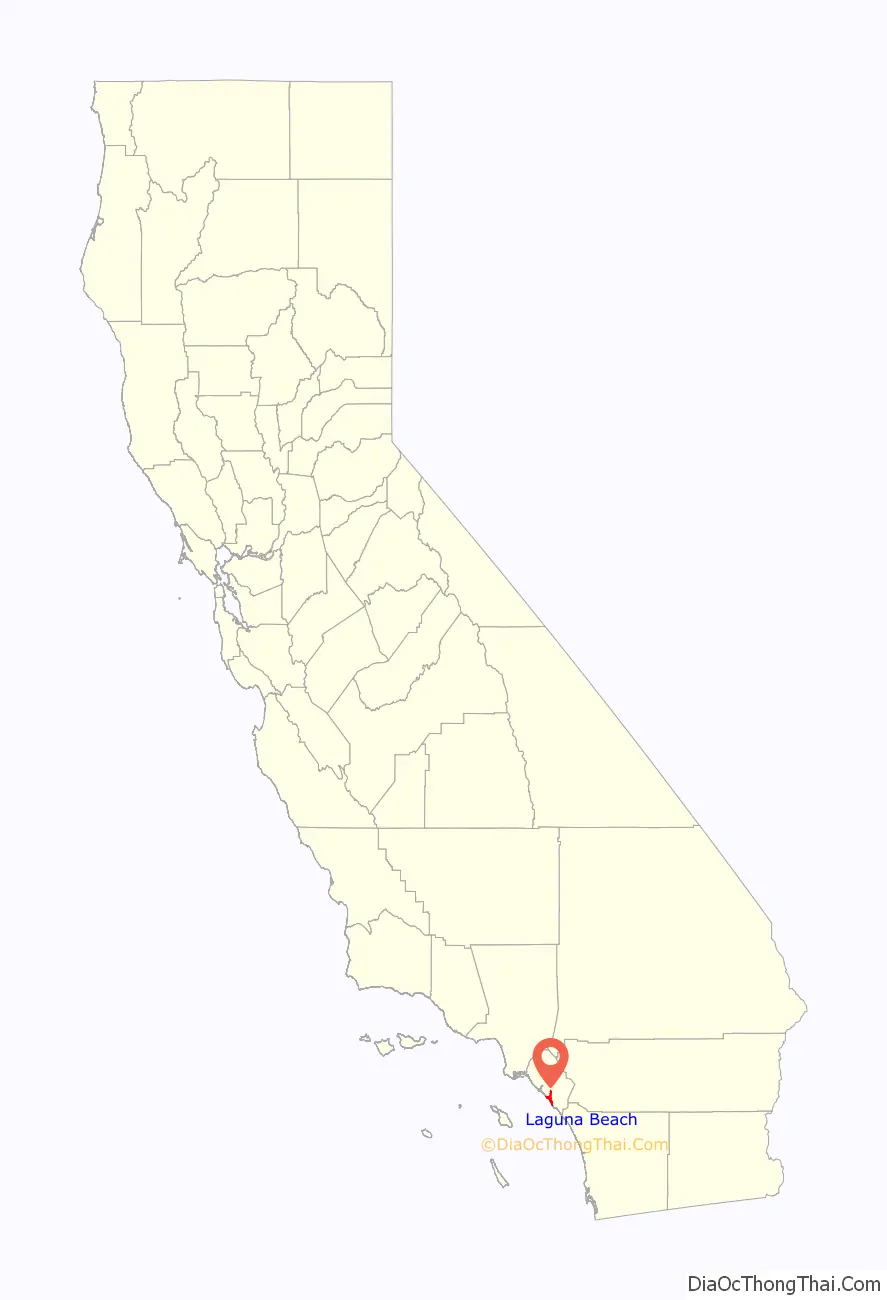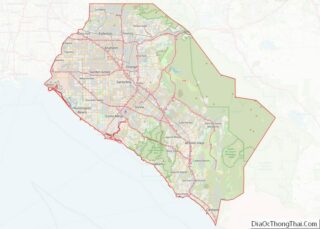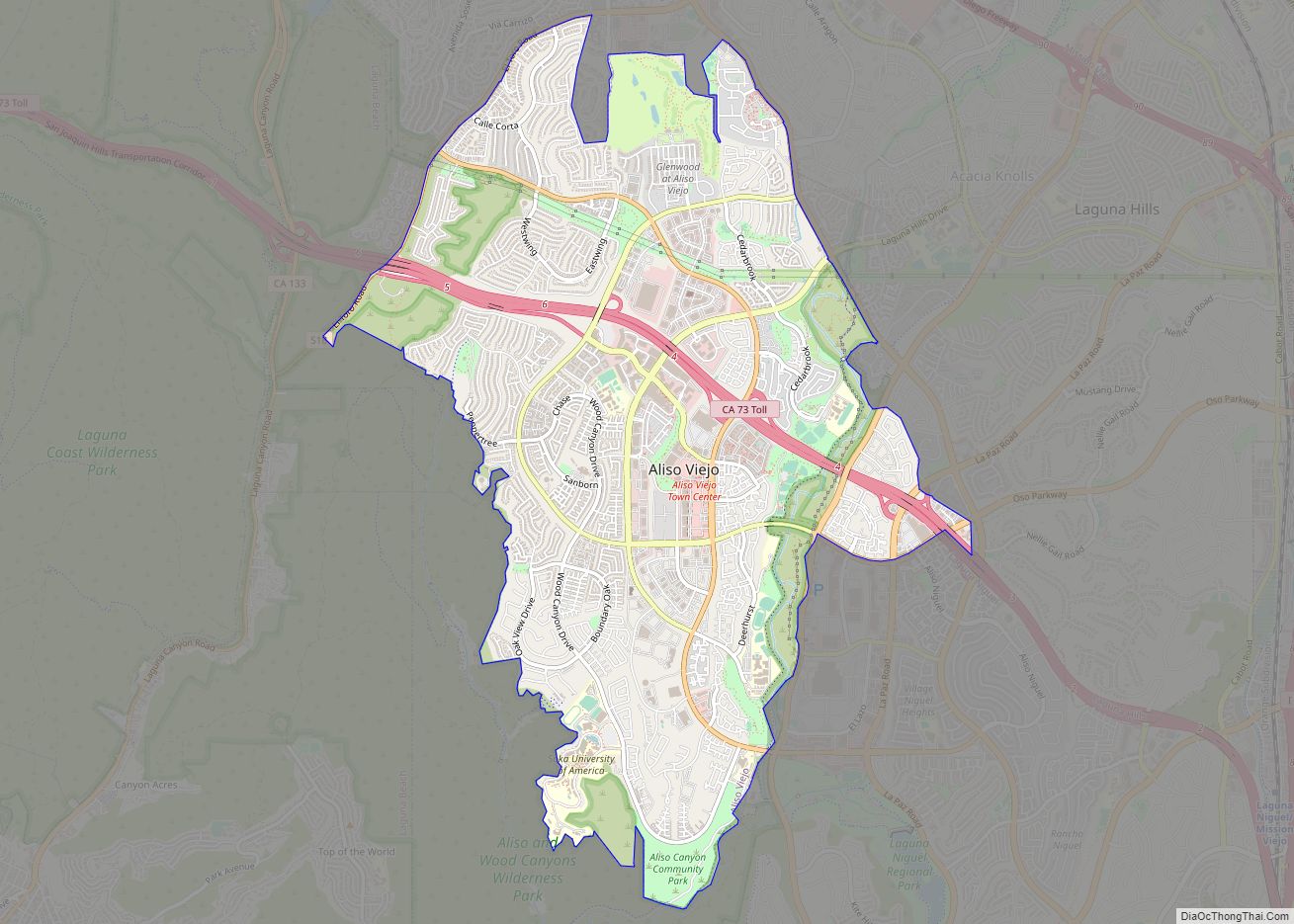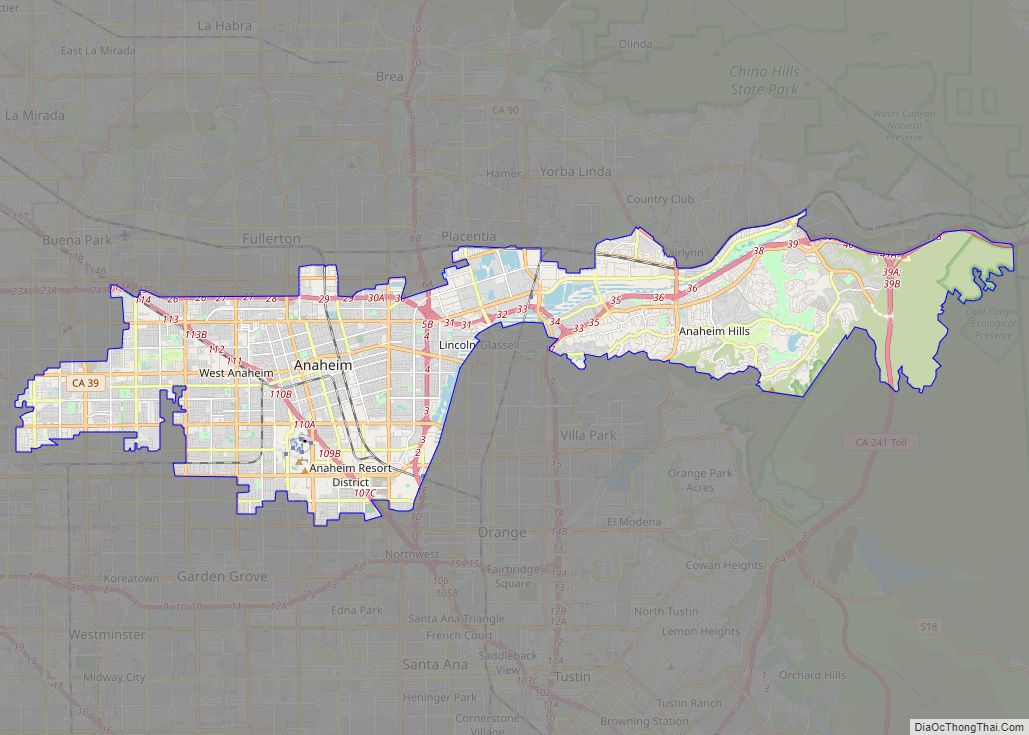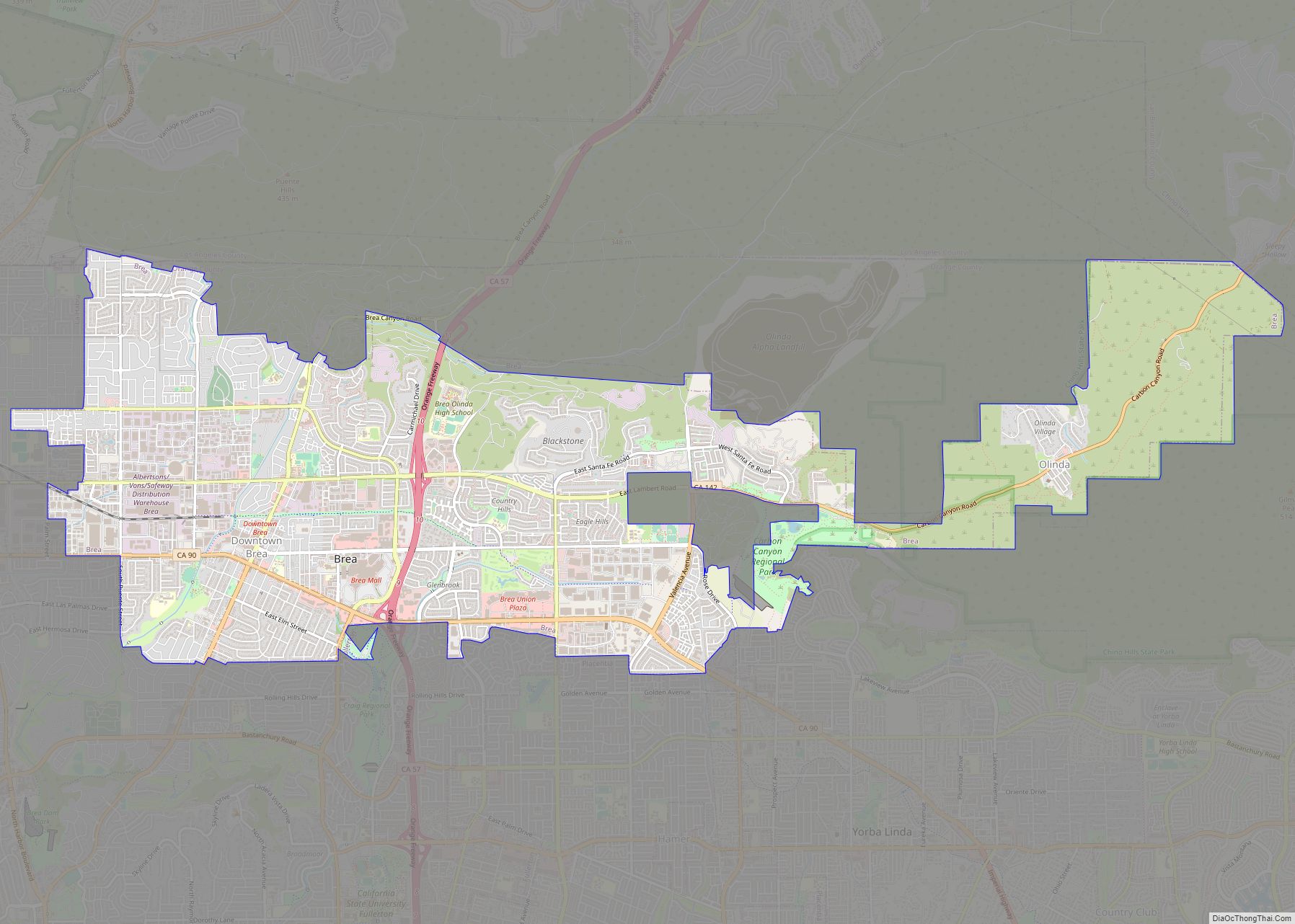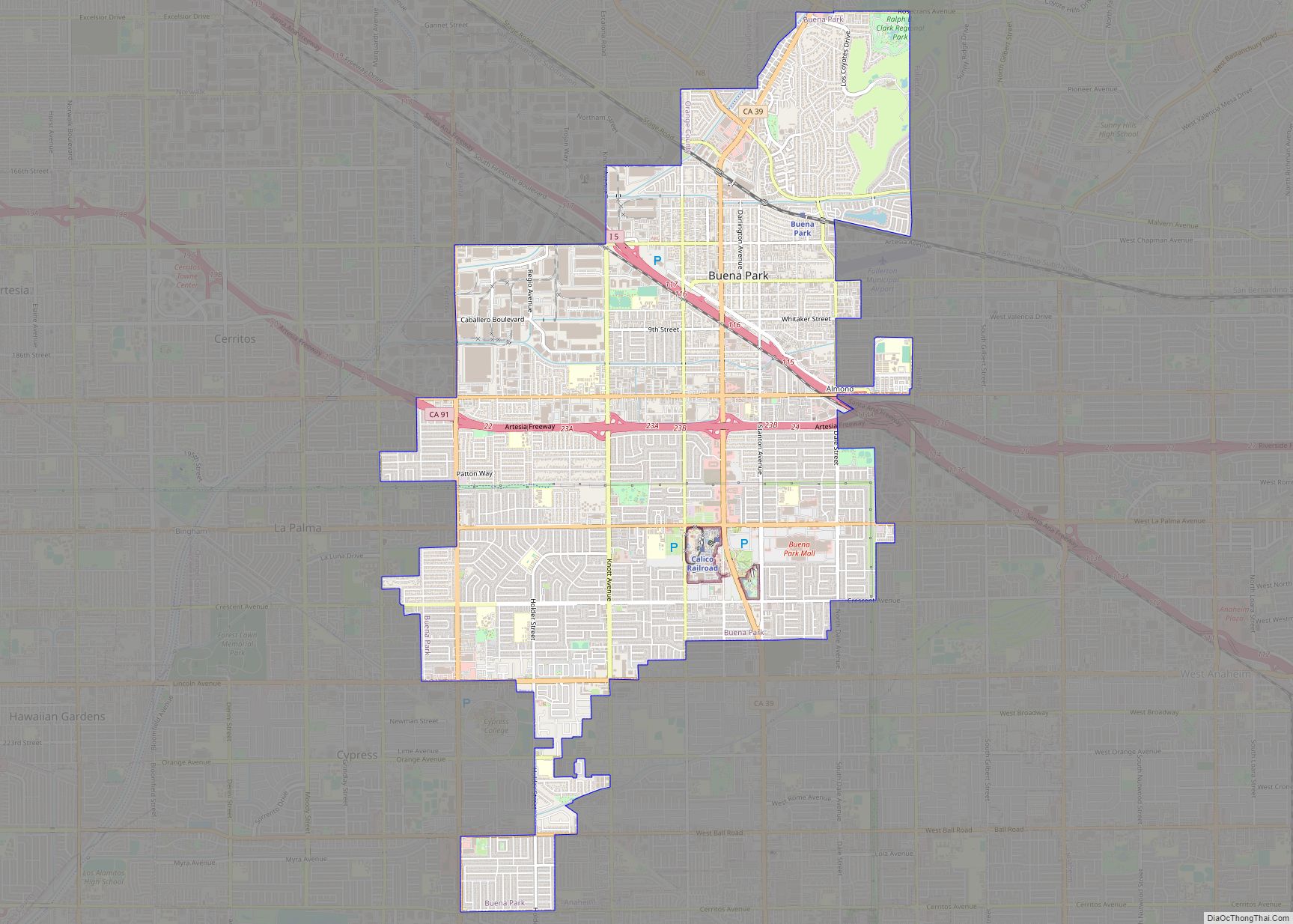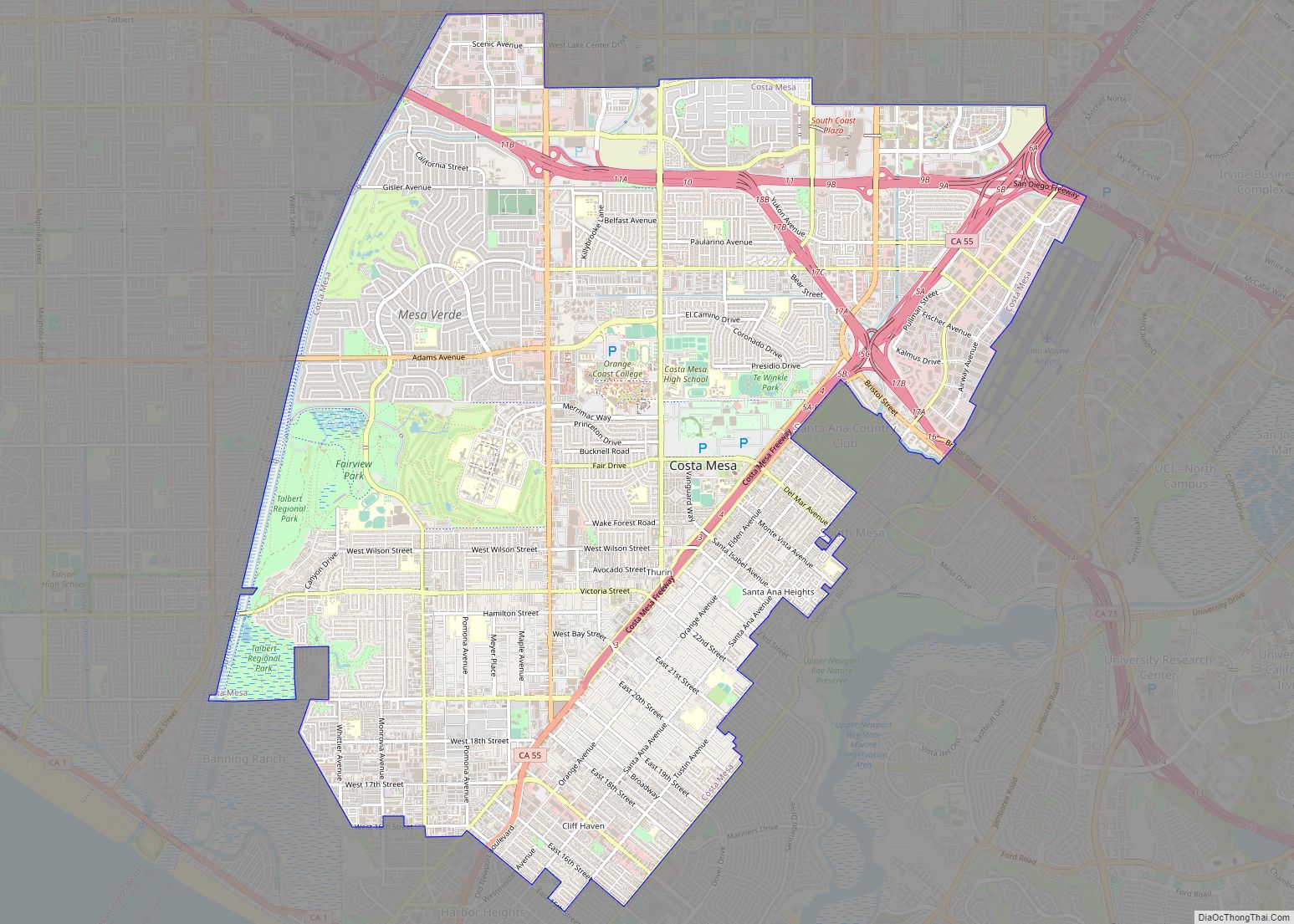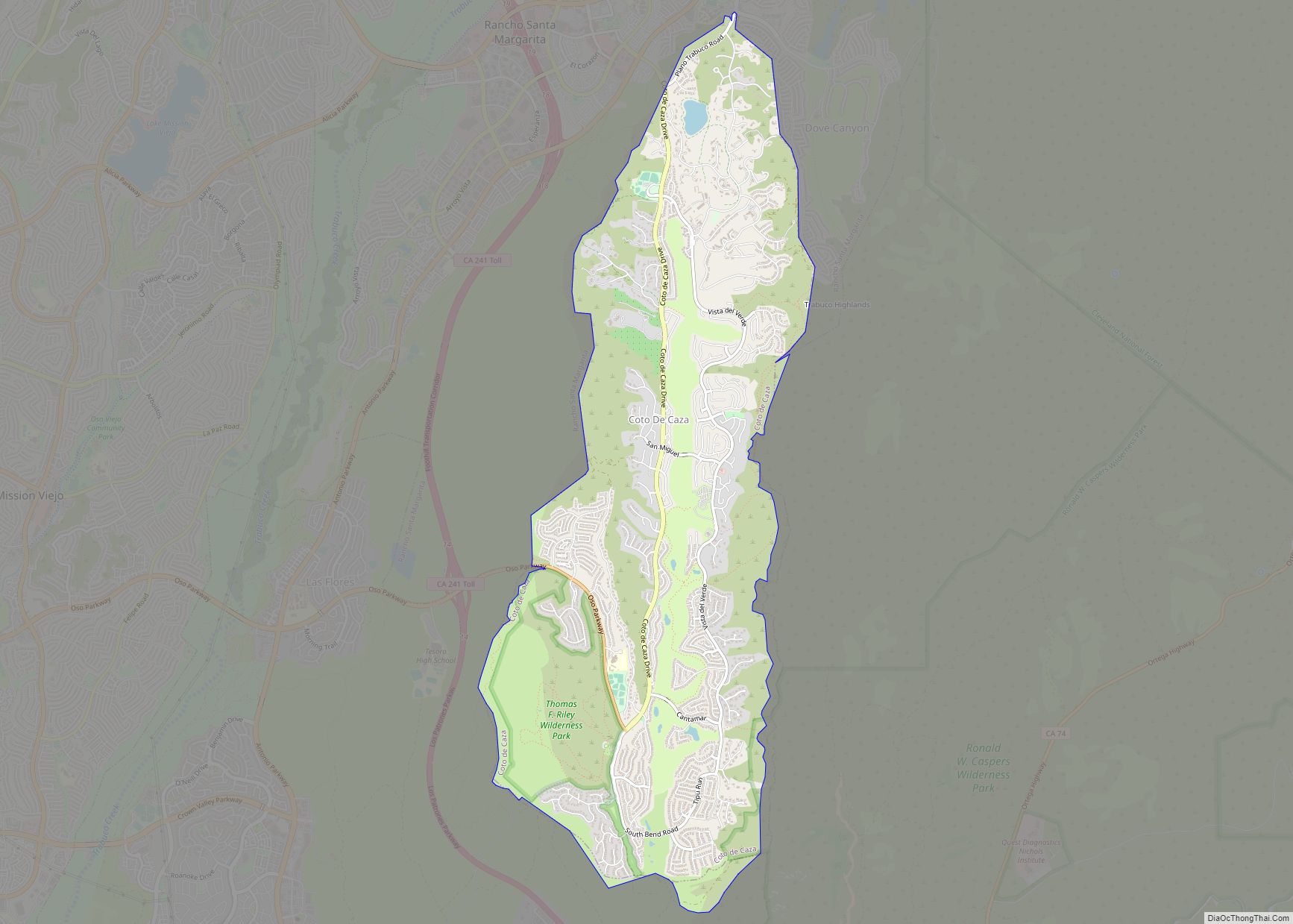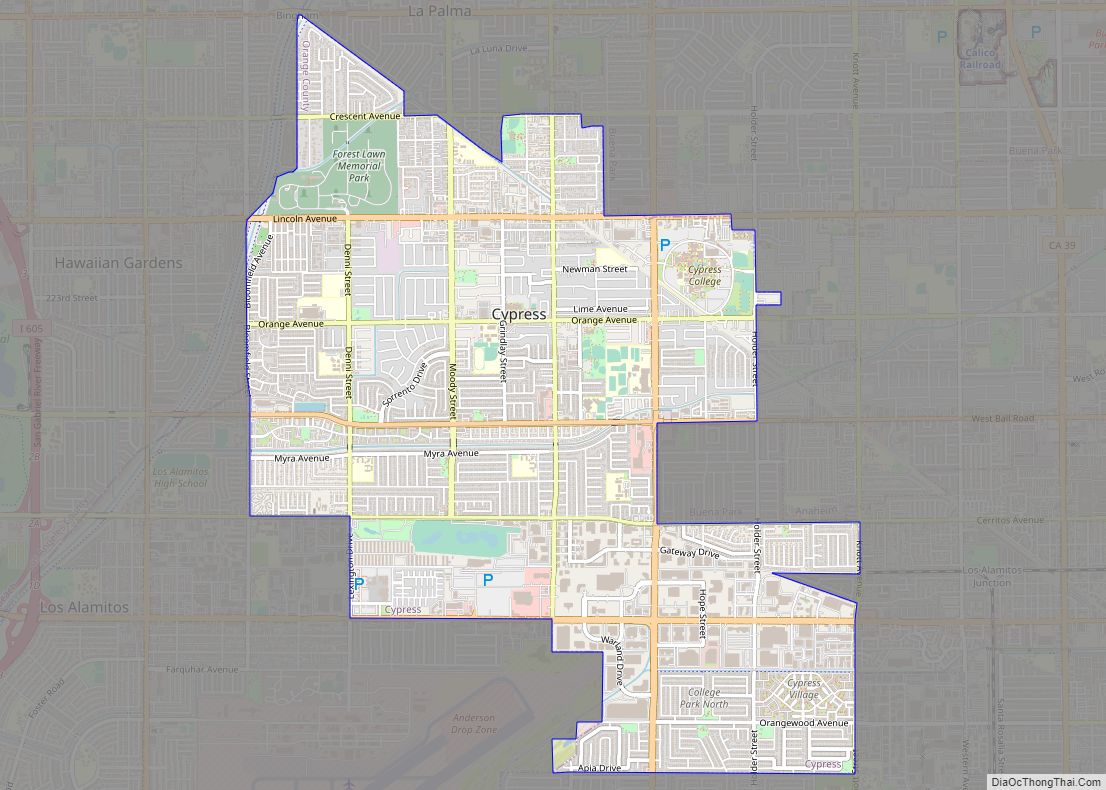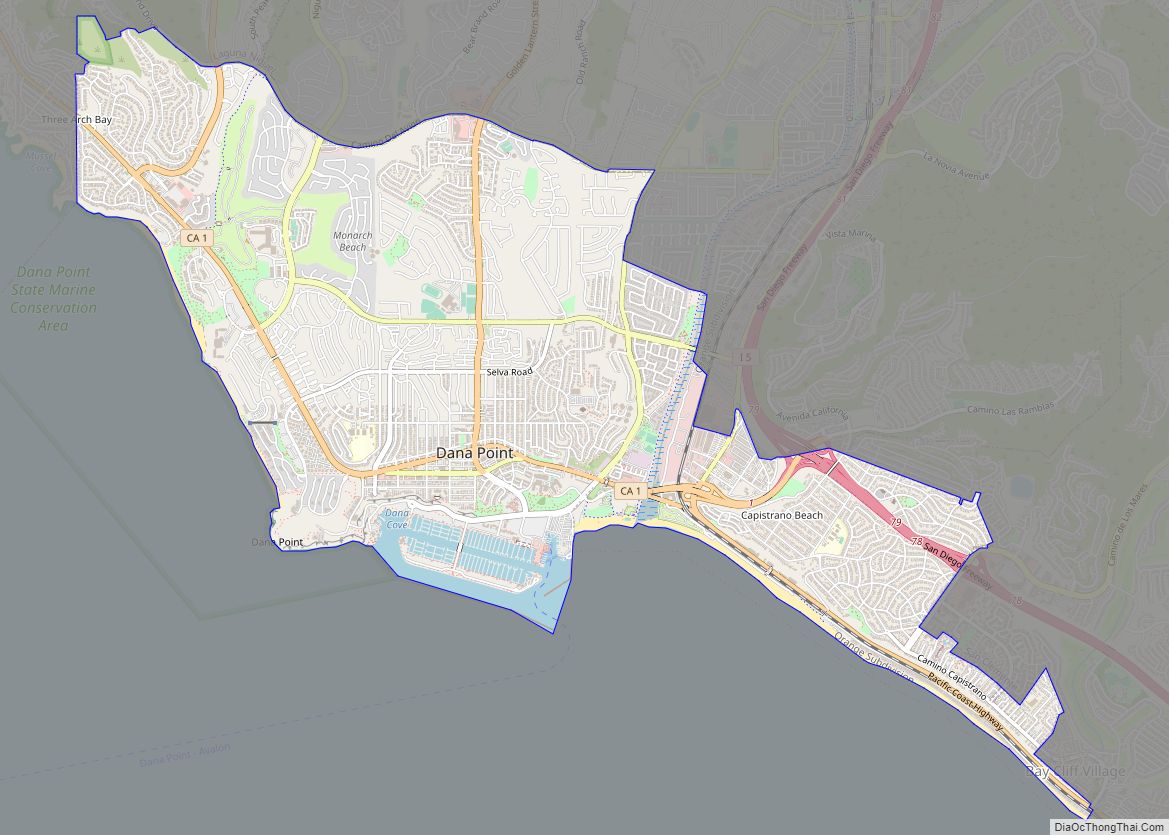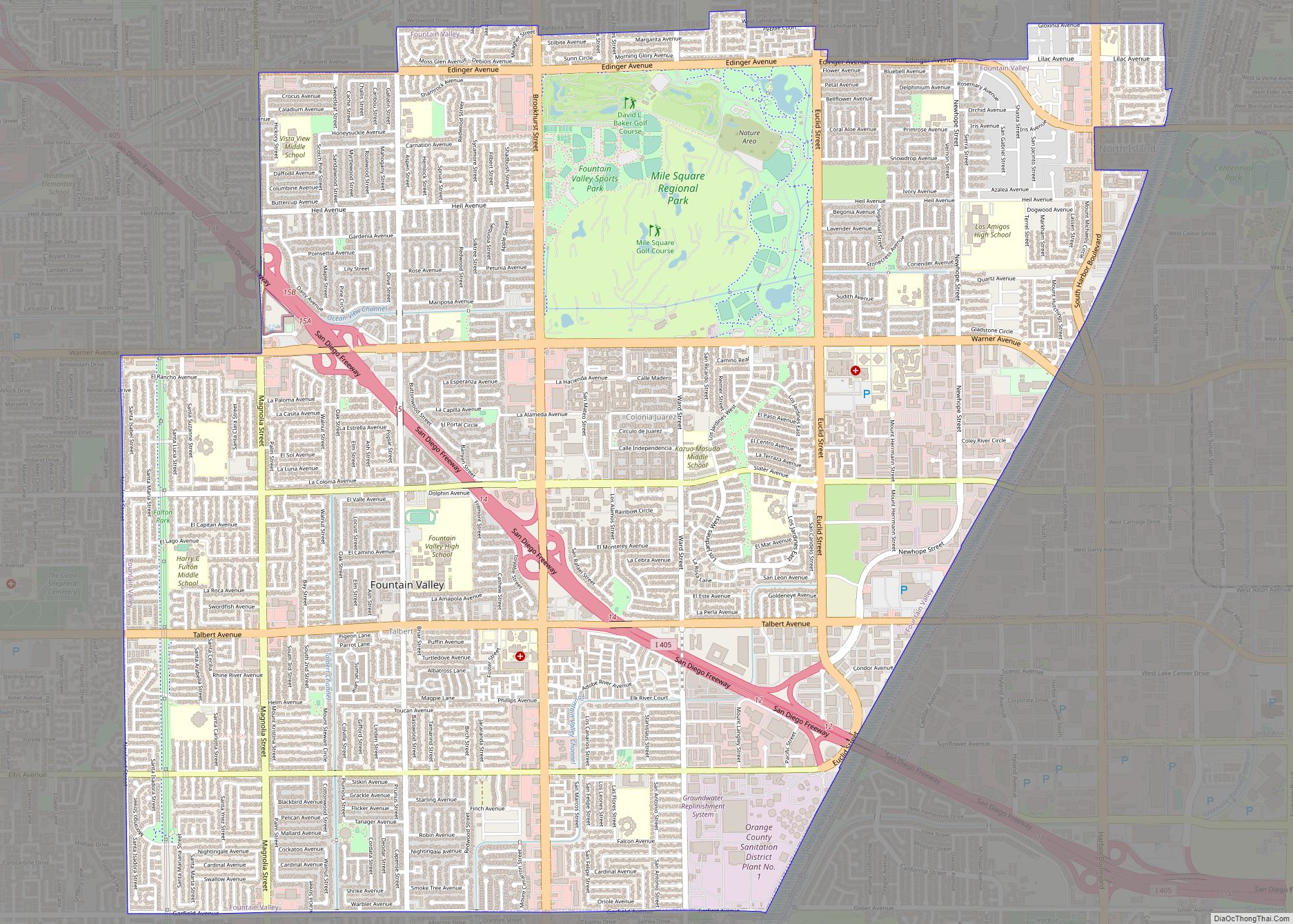Laguna Beach (/ləˈɡuːnə/; Laguna, Spanish for “Lagoon”) is a city in Orange County, California, United States. Located in Southern California along the Pacific Ocean, this seaside resort city has a mild year-round climate, scenic coves, and environmental preservation efforts. The population in the 2020 census was 23,032.
Historically settled by Paleoindians, the Tongva people, and then Mexico, the location became part of the United States following the Mexican–American War. Laguna Beach was settled in the 1870s, officially founded in 1887, and in 1927 its current government was incorporated as a city. The city adopted the council–manager form of government in 1944. The city has remained relatively isolated from urban encroachment by its surrounding hills, limited highway access, and dedicated greenbelt. The Laguna Beach coastline is protected by 5.88 miles (9.46 km) of state marine reserve and an additional 1.21 miles (1.95 km) of state conservation area.
Tourism is the primary industry with an estimated six million people visiting the community annually. Large annual events include the Pageant of the Masters, Festival of Arts, Sawdust Art Festival, Art-A-Fair, Bluewater Music Festival, and Kelpfest.
| Name: | Laguna Beach city |
|---|---|
| LSAD Code: | 25 |
| LSAD Description: | city (suffix) |
| State: | California |
| County: | Orange County |
| Elevation: | 20 ft (6 m) |
| Total Area: | 9.86 sq mi (25.55 km²) |
| Land Area: | 8.89 sq mi (23.04 km²) |
| Water Area: | 0.97 sq mi (2.51 km²) 9.89% |
| Total Population: | 23,032 |
| Population Density: | 2,300/sq mi (900/km²) |
| Area code: | 949 |
| FIPS code: | 0639178 |
| Website: | lagunabeachcity.net |
Online Interactive Map
Click on ![]() to view map in "full screen" mode.
to view map in "full screen" mode.
Laguna Beach location map. Where is Laguna Beach city?
History
Laguna Beach was the site of a prehistoric paleoindian civilization. In 1933, the first fossilized skull of a paleoindian found in California was uncovered during construction on St. Ann’s Drive. Known as “Laguna Woman”, the skull originally was radiocarbon dated to more than 17,000 BP, but revised measurements suggest it originated during the Holocene era, 11,700 years BP. Subsequent research has found several prehistoric encampment sites in the area.
The indigenous people of the Laguna Beach area were the Tongva. Aliso Creek served as a territorial boundary between Gabrieleno and Acjachemen groups, or Juanenos, named by Spanish missionaries who first encountered them in the 1500s. The area of Laguna Canyon was named on an 1841 Mexican land grant map as Cañada de las Lagunas (English: Glen of the Lagoons). After the Mexican–American War ended in 1848, the area of Alta California was ceded to the United States. The treaty provided that Mexican land grants be honored and Rancho San Joaquin, which included north Laguna Beach, was granted to José Antonio Andres Sepúlveda. Following a drought in 1864, Sepúlveda sold the property to James Irvine. The majority of Laguna Beach was one of the few parcels of coastal land in Southern California that never was included in any Mexican land grant.
Settlers arrived after the American Civil War. They were encouraged by the Homestead Act and Timber Culture Act, which granted up to 160 acres (65 ha) of land to a homesteader who would plant at least 40 acres (16 ha) of trees. In Laguna Beach, settlers planted groves of eucalyptus trees. In 1871, the first permanent homestead in the area was occupied by the George and Sarah Thurston family of Utah on 152 acres (62 ha) of Aliso Creek Canyon. In 1876, the brothers William and Lorenzo Nathan “Nate” Brooks purchased tracts of land in Bluebird Canyon at present-day Diamond Street. They subdivided their land, built homes and initiated the small community of Arch Beach. In his book, History of Orange County, California (1921), Samuel Armor cited the permanent homestead of Nate Brooks as the beginning of the modern day town and described Brooks as the “Father of Laguna Beach”.
The community in Laguna Canyon and around the main beach expanded during the 1880s. The city officially founded a post office in 1887 under the name Lagona, but the postmaster in 1904, Nicholas Isch, successfully petitioned for a name correction to Laguna Beach. By then Laguna Beach already had developed into a tourist destination. Hubbard Goff built a large hotel at Arch Beach in 1886, which later was moved and added to Joseph Yoch’s Laguna Beach Hotel built in 1888 on the main beach. Visitors from local cities pitched tents on the beaches for vacation during the warm summers.
The scenic beauty of the isolated coastline and hills attracted plein-air painters in the early 1900s. William Wendt, Frank Cuprien, and Edgar Payne among others settled there and formed the Laguna Beach Art Association. The first art gallery opened in 1918 and later became the Laguna Beach Art Museum. Precursors to The Festival of Arts and the Pageant of the Masters began in 1921, and eventually were established in their present-day form by Roy Ropp in 1936. Due to its proximity to Hollywood, Laguna also became a favorite filming location. Starting in 1913, dozens of silent films were made at local coves with Harold Lloyd, Mary Pickford, Douglas Fairbanks Jr., and others. Actors and film crews stayed during long production shoots at the Arch Beach Tavern on the hillside above Moss Street.
The arrival of painters, photographers, filmmakers, and writers established Laguna Beach as a noted artist community. Although there only were approximately 300 residents in 1920, a large proportion of them worked in creative fields. The small town remained isolated until 1926 because the long, winding Laguna Canyon road served as the only access. With the completion of the Pacific Coast Highway in 1926, a population boom was expected. To protect the small-town atmosphere of the art colony, residents who called themselves “Lagunatics” pushed for incorporation. The municipal government for Laguna Beach incorporated as a city on June 29, 1927. The city has experienced steady population growth since that time, rising from 1,900 residents in 1927 to more than 10,000 in 1962, and becoming four times larger in area.
Many creative, bohemian, and wealthy people have made Laguna Beach their home. They have added to the local culture by providing a theme for the small town. Adventurer Richard Halliburton built his Hangover House on the slopes of South Laguna. Hildegarde Hawthorne, granddaughter of the novelist Nathaniel Hawthorne, described Laguna “as a child of that deathless search, particularly by persons who devote their lives to painting or writing, or for some place where beauty and cheapness and a trifle of remoteness hobnob together in a delightful companionship.”
Laguna Beach was the Southern California epicenter of the ‘alternative’ hippie culture in the late 1960s and early 1970s. In early 1967, John Griggs and other founding members of the Brotherhood of Eternal Love relocated from Modjeska Canyon to the Woodland Drive neighborhood of Laguna Beach, which they later renamed “Dodge City”. Timothy Leary lived in a beach house on Gaviota Drive. The Utsava Rajneesh Meditation Center was located on Laguna Canyon Road and was the last remaining commune in the United States for followers of the spiritual teacher and guru Osho, Bhagwan Shree Rajneesh.
The city was deemed a smoke-free place by Laguna Beach Council on May 23, 2017. Ordinance 1624 was imposed by the Beach Council to prohibit smoking in all public places in the city.
1993 fire
In October 1993, a fire in Laguna Beach destroyed or damaged 441 homes and burned more than 14,000 acres (5,700 ha). The National Fire Protection Association listed it as the seventh-largest loss wildland fire in the United States. To avoid a recurrence of the damage to animals that occurred during the fire, a wildlife corridor is being created between Laguna Beach and the Cleveland National Forest in order to ensure that animals can retreat fire safely if needed.
Laguna Beach Road Map
Laguna Beach city Satellite Map
Geography
Laguna Beach is part of the Los Angeles metropolitan area. According to the United States Census Bureau, Laguna Beach has a total area of 25.4 km (9.8 sq mi), of which 22.9 km (8.8 sq mi) are land and 2.5 km (0.97 sq mi) are covered by water. Its coastline is 7 mi (11 km) long and includes 27 beaches and coves. It is bordered by the Pacific Ocean on the southwest, Crystal Cove State Park on the northwest, Laguna Woods on the northeast, Aliso Viejo and Laguna Niguel on the east, and Dana Point on the southeast. It also borders the unincorporated community of Emerald Bay, which divides the northernmost part of its coastline (Irvine Cove) from the rest of the city’s coast.
The land in and around Laguna Beach rises quickly from the shoreline into the hills and canyons of the San Joaquin Hills. The town’s highest point, at an elevation of 1,007 feet (307 m), is Temple Hill in the Top of the World neighborhood. Because of its hilly topography and surrounding parklands, few roads run into or out of town; only the Coast Highway connecting to Newport Beach to the northwest and to Dana Point to the south, and State Route 133 crossing the hills in a northeastern direction through Laguna Canyon. Parts of Laguna Beach border the Aliso/Wood Canyons Regional Park.
The natural landscape of beaches, rocky bluffs, and craggy canyons have been noted as sources of inspiration for plein air painters and landscape photographers who have settled in the Laguna Beach since the early 1900s. The hills also are known internationally for mountain biking. Laguna Coast Wilderness Park is a 7,000-acre (2,800 ha) wilderness area in the hills surrounding Laguna Beach. This park features coastal canyons, ridgeline views, and the only natural lakes in Orange County. Wildlife that can be found on Laguna Beach includes the Lined Shore Crab, Black Oystercatchers, Barred Sand Bass, Spiny Lobsters and the Great White Egret.
Climate
Under the Köppen climate classification, Laguna Beach has a Cold semi-arid climate classified as BSk. The weather is considered mild with abundant sunshine all year. The average daily high temperature ranges from 68 °F (20 °C) in January to 80 °F (27 °C) in August. Mean annual precipitation is relatively low, at 13.56 inches (344 mm). The average ocean water temperatures range from about 59 °F (15 °C) in February to 68 °F (20 °C) in August, with early to mid-September water temperatures often peaking at about 72 °F (22 °C). However, the ocean surface temperatures along the beaches of Laguna Beach may vary by several degrees from the average, dependent upon offshore winds, air temperature, and sunshine.
See also
Map of California State and its subdivision:- Alameda
- Alpine
- Amador
- Butte
- Calaveras
- Colusa
- Contra Costa
- Del Norte
- El Dorado
- Fresno
- Glenn
- Humboldt
- Imperial
- Inyo
- Kern
- Kings
- Lake
- Lassen
- Los Angeles
- Madera
- Marin
- Mariposa
- Mendocino
- Merced
- Modoc
- Mono
- Monterey
- Napa
- Nevada
- Orange
- Placer
- Plumas
- Riverside
- Sacramento
- San Benito
- San Bernardino
- San Diego
- San Francisco
- San Joaquin
- San Luis Obispo
- San Mateo
- Santa Barbara
- Santa Clara
- Santa Cruz
- Shasta
- Sierra
- Siskiyou
- Solano
- Sonoma
- Stanislaus
- Sutter
- Tehama
- Trinity
- Tulare
- Tuolumne
- Ventura
- Yolo
- Yuba
- Alabama
- Alaska
- Arizona
- Arkansas
- California
- Colorado
- Connecticut
- Delaware
- District of Columbia
- Florida
- Georgia
- Hawaii
- Idaho
- Illinois
- Indiana
- Iowa
- Kansas
- Kentucky
- Louisiana
- Maine
- Maryland
- Massachusetts
- Michigan
- Minnesota
- Mississippi
- Missouri
- Montana
- Nebraska
- Nevada
- New Hampshire
- New Jersey
- New Mexico
- New York
- North Carolina
- North Dakota
- Ohio
- Oklahoma
- Oregon
- Pennsylvania
- Rhode Island
- South Carolina
- South Dakota
- Tennessee
- Texas
- Utah
- Vermont
- Virginia
- Washington
- West Virginia
- Wisconsin
- Wyoming

